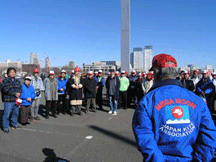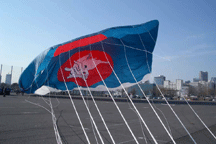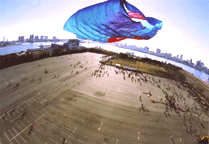Entries by Hifliercanada (97)
Interview With Inventor of Magenn Kite Rotor Generator
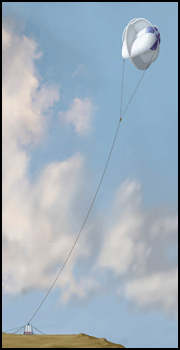 The Best-Breezes blog entry of January 7, 2006 about the Magenn MARS (Magenn Air Rotor System) was so well received by readers that it prompted me to investigate more deeply the relationship that this high tech electrical energy generator has with the simple rotor kite that inspired the concept.
The Best-Breezes blog entry of January 7, 2006 about the Magenn MARS (Magenn Air Rotor System) was so well received by readers that it prompted me to investigate more deeply the relationship that this high tech electrical energy generator has with the simple rotor kite that inspired the concept.
Readers from both the kite community and general visitors seeking information on an innovative source of power generation asked how the concept to use a kite in such a novel manner originated.
I contacted Fred Ferguson of Magenn Power Inc. and asked for an interview to help my readers understand more about the MARS and its relationship to the horizontal rotor kite. Fred, the founder of Magenn, graciously accepted and below you will find his answers to questions posed by Best-Breezes.
__________
Best-Breezes: "What inspired you to use the modified rotor kite concept for your aerial wind power generation system?"
Fred Fergusson of Magenn Power Inc:
"The rotor kite concept was somewhat of a natural evolution from our extensive work on rotating sphere airships in the 1980s. The Magnus Aerospace airship utilized the same aerodynamics as a rotor kite. In 2002 I read an article about using a traditional kite or glider system to generate electricity. This inspired me to look back at the magnus airship work whereby the sphere could free wheel in the wind with rotor kite like blades. This evolved to the design we have today. "
Best-Breezes: "What are the advantages of your Magenn Air Rotor System (MARS) over traditional, stationary wind turbines?"
Fred Ferguson:
"The Magenn rotor is an inflatable structure that, like a blimp, can be built in very large sizes at relatively low cost. The main advantage of the Magenn rotors is their Power output (power coefficient) vs capital cost when compared to equivalent output wind turbines. Other features such as mobility, no tower required, low operating speed, ability to get up into higher winds and better wind speed latitude are also competitive factors."
Best-Breezes: "Kite fliers would be interested to know how much research you did on "horizontal rotor kites" as a part of your concept development?"
Fred Ferguson:
"Most of our research relates to the magnus effect. In the 1980s we conducted over 160 wind tunnel tests to fully understand the properties of this unusual aerodynamic effect. My first rotor kite was purchased about 1984, it was similar to the traditional shape two end disk versions we see today. This helped proved certain aspect that we had discovered in the wind tunnel tests. Today we have a very large library and understanding of the magnus effect."
Best- Breezes: "Which sources of information on rotor kites were of most use to your team?"
Fred Ferguson:
"Today the best information comes from the internet. The most recent kite purchase was a UFO silver mylar rotor kite with the single center disk. In the past I have found sites such as Anthony's Kite workshop (anthony@cit.gu.edu.au ) , or Philip Le Riche's Virtual Kite Zoo to be helpful sources."
Best-Breezes: "Did you acuire, build or fly any rotor kite models as part of the development of your Magenn Air Rotor System (MARS)? If so, what did you learn from these that helped you with your concept design?"
Fred Ferguson:
"The rotor kites are very useful to demonstrate the magnus effect. The kites provided the necessary proof when designing the Magenn rotor as a cylindrical type device. The rotor kites also demonstrate enhanced stability, drag vs lean, and of course lifting effect. All components of the magnus aerodynamic effect."
Best- Breezes: "What part does the 'rotor kite' design play in keeping your MARS stable and directed into the wind?"
Fred Fergusson:
"As mentioned above just about every feature of a rotor kite applies to the Magenn rotor, enhanced stability, side or center stabilizer design, yoke cable, single tether, axial spin, etc. The mangus effect lift is an active component it's just that this lift is diminished by slowing the rotor speed due to the generator power load."
Best-Breezes:
"Have you developed any prototype models of a small size to date? If so, how do they seem to 'fly' in test conditions?"
Fred Ferguson:
Other than flying versions of rotor kites, and the past magnus airship program (which included flying prototypes) all of our current work has focused on test bed and wind tunnel modeling. We expect to see the first large flying prototype this coming summer (2006).
Best-Breezes:
"Do you have any plans to develop mini versions of your MARS, without the electrical generation capacity, to sell to interested kite fliers? Knowing that many kiters are seeking novel kites for flight when they go to kite festivals, this could be a marvelous, low cost publicity option."
Fred Ferguson: "That is an excellent idea . . . "
Best- Breezes: "Thank you Fred for taking the time to answer questions that are of interest to kite flyers. Certainly your innovative and cutting edge work applying kite technology to generate renewable energy is innovative and interesting. I know that all kite fliers wish you well with your project and we will be following your story closely. Perhaps some day you will grace us at a kite festival with a demonstration model. I know that kite enthusiasts everywhere will be attracted by your marvelous device!"
__________
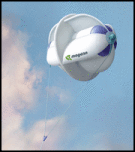 Since our original posting about the Magenn Power Air Rotor, the company has entered into an agreement with the Krystal Planet Corporation of Kansas City to distribute the MARS airborne tethered wind generators in the summer of 2006. All of this is exciting news for the clean, renewable energy market. Congratulations to both Magenn Power Inc., of Kanata, Ontario, and the Krystal Planet Corporation of Lenexa, Kansas, U.S.A.
Since our original posting about the Magenn Power Air Rotor, the company has entered into an agreement with the Krystal Planet Corporation of Kansas City to distribute the MARS airborne tethered wind generators in the summer of 2006. All of this is exciting news for the clean, renewable energy market. Congratulations to both Magenn Power Inc., of Kanata, Ontario, and the Krystal Planet Corporation of Lenexa, Kansas, U.S.A.
Acknowledgements
Sincere appreciation is extended to Fred Ferguson of Magenn Power Inc. for taking the time to correspond with Bes-Breezes on a number of occasions. His thoughtful answers to questions of interest to kite fliers will be appreciated by readers of this site and journal. It is our hope that we will be able to meet Fred at a kite festival very soon. We look forward to seeing a demonstration model of his innovative kite rotor which will be a source of renewable energy.
Images of the MARS are courtesy of the Magenn Power Inc. web site.
Kite Ban Law Continues to Confound Pakistan
 In an effort to interpret the law banning the flying of kites with coated strings in Pakistan, the state of Punjab recently passed a law covering the manufacture and sale of kites and kite line that would require maunfacturers to register with the state. In addition, the ordinance permits kite flying under certain circumstances during a fifteen day period in the spring of each year.
In an effort to interpret the law banning the flying of kites with coated strings in Pakistan, the state of Punjab recently passed a law covering the manufacture and sale of kites and kite line that would require maunfacturers to register with the state. In addition, the ordinance permits kite flying under certain circumstances during a fifteen day period in the spring of each year.
On January 23, 2006, Geo TV of Pakistan reported:
LAHORE: Punjab Government has promulgated Punjab Prohibition of Kite flying (Amendment) Ordinance, 2006 which will come in to force immediately.
According to a press release issued by Government of Punjab, no person would be allowed to manufacture under the ordinance, sell or offer for sale metallic wire, nylon cord (tandi), any other thread coated with sharp maanjha or any other injurious material for the purpose of kite flying.
Violators of the Ordinance would be liable to imprisonment for 3 years or to a fine of Rs.40,000/- or both.
The Nazim of the concerned district, through a notification, issued with the prior approval of the government, could allow kite flying and sale of kites for a period not exceeding 15 days during the spring season in a year provided that kite manufacturing is allowed for such period as the government may specify by general or special order.
Every manufacturer, trader or seller of kites or kite flying materials will get himself registered with the concerned City District Government or the District Government in the manner as may be prescribed by the government through a notification.
However, this was immediately challenged the following day by the former Vice-President of the Supreme Court of Pakistan.
The Daily Times of Pakistan reported that Muhammad Ikram Chaudhry called the ordinance “contempt of court”, saying that it allows kite flying for a specific time in Punjab despite the fact that the Pakistan's highest court has imposed a countrywide ban on it. Chaudhry claimed that the ordinance was a “clear violation” of the ban and also contrary to Article 9 (Safety and Security of Citizens) of the Constitution.
Adding to the volatility of the issue was another major power outage in Lahore, Pakistan caused by kite flying that took place in spite of the Supreme Court ban on the activity. The Daily Times of Pakistan suggested that police seem to be able to do little to control the sport.
Kite flying is so deeply imbedded in the culture of Pakistan that one wonders how the situation will be resolved. The high cost of power outages, the accidents causing injury to kite fliers and bystanders, and the occasional death all make the issue a very complex one for the nation.
Kite flying in Pakistan is very different from that in North America, Europe, Australia and New Zealand. In these nations, kite flyers do not engage in battles to cut one another out of the sky. Whereas in Pakistan, the measure of kite flying skill is the ability to outmaneuvre an opponent and take his or her kite out of the sky by cutting the flying line.
This issue will take a long time to resolve and I anticipate that there will be additional postings on this matter.
It's All About Ben - the electrifying kite flyer!
 January 17, 2006 is the 300th anniversary of the birth of Ben Franklin. You can definitely say that this year, the Tercentenary of Benjamin Franklin's birth, will be "..all about Ben.."!
January 17, 2006 is the 300th anniversary of the birth of Ben Franklin. You can definitely say that this year, the Tercentenary of Benjamin Franklin's birth, will be "..all about Ben.."!
Although kite fliers celebrate his kiting prowess, evident long before it was cool to be known as a kite flyer, there is more to Ben than a couple of dramatic events with kites.
Sure, he was daring enough to dangle a key from a wet cotton kite line as the kite itself danced in the electrically charged thunderclouds overhead. Truly a shocking thing for a kite flyer to do even if it was an attempt to prove a scientific theory. Today, we all pull our kites in at the first sign of approaching heavy weather since we are well aware of the inherent dangers of hanging on to a line as we stand on 'the ground' while our kite is gathering positive electrons in the upper air.
 We also applaud his dramatic use of a kite to pull him across a pond on a glorious summer day. To show his casual confidence and panache, Franklin attached the kite to his toe as the forces of kite traction were harnessed in an elegant manner. Surely reading this bit of history cannot be where Peter Lynn had his Eureka moment that led to kite boarding and his new "Kite-Cat"!
We also applaud his dramatic use of a kite to pull him across a pond on a glorious summer day. To show his casual confidence and panache, Franklin attached the kite to his toe as the forces of kite traction were harnessed in an elegant manner. Surely reading this bit of history cannot be where Peter Lynn had his Eureka moment that led to kite boarding and his new "Kite-Cat"!
Yes, indeed, Benjamin Franklin does inspire we modern day kiters.
However, 2006 is all about Ben for more than the kite related escapades that we revere. This year Ben is celebrated because of his huge contributions to so many innovations and principles that we take for granted today.
To properly celebrate his genius, achievements, inspirational leadership and legacy a special foundation was created. The Benjamin Franklin Tercentenary is a private, non-profit alliance established to mark the three-hundred-year anniversary of Benjamin Franklin’s birth (1706-2006) with a celebration dedicated to educating the public about Franklin’s enduring contributions and inspiring renewed appreciation of the values he embodied.
So, as much as we kite enthusiasts would like to celebrate him as a brilliant man who saw the virtues of being a kite flyer, we have to be realistic and acknowledge that his claim to fame and his impact on his times was founded on more than his kite adventures.
 For a great review of Benjamin Franklin's life through the lens of a kite historian, visit Margaret Robinson's thorough article on his life and contributions. Entitled "Kites in the Age of Reason". The article was originally published in KITING, The Journal of the American Kitefliers Association, Spring 2002, Volume 24, Issue 1. Meg gives a detailed outline of his life and places due emphasis, for kite afficionados, on Franklin's use of the kite in pursuit of theories of electricity in an age when all of these concepts were just being explored.
For a great review of Benjamin Franklin's life through the lens of a kite historian, visit Margaret Robinson's thorough article on his life and contributions. Entitled "Kites in the Age of Reason". The article was originally published in KITING, The Journal of the American Kitefliers Association, Spring 2002, Volume 24, Issue 1. Meg gives a detailed outline of his life and places due emphasis, for kite afficionados, on Franklin's use of the kite in pursuit of theories of electricity in an age when all of these concepts were just being explored.
Of particular interest to kiters is the web page entitled simply "Franklin's Kite" Here we can see in a laboratory setting how kites can attract electricity and the rather dramatic effects of the spark. In particular, it is worth downloading the video clip of a kite being struck by simulated lightning. If ever you doubted the safety reasons behind getting your kite out of a bad weather sky, this will 'charge' you to think again!
Now, just when we were pleased that such a notable person as Ben Franklin used a kite in the famous electricity experiment, I have to rudely tug on your kite line. Tom Tucker, in his 2003 book Bolt of Fate: Benjamin Franklin and His Fabulous Kite, strikes out at the notion that Franklin actually conducted his celebrated experiment with the kite and lightning. Dr. Tucker, a lecturer and historian at the Isothermal Technical College in North Carolina, first began to suspect the story while working for NASA. Tucker examined the original documents, and found that accounts by Franklin were vague about when and where the experiment was performed. He then went on to try to replicate the experiment, safely of course, using materials available in the mid-18th century.
 Dr. Tucker finally concluded that it could not have been done. Tucker stated: "I followed the design of the kite and tried it several times - and it just wouldn't fly." ... "Even if it had, there was no way it could have reached the heights needed to draw electricity from thunderclouds." (See: "Benjamin Franklin 'faked kite experiment' - based on an interview with Dr. Tom Tucker by Robet Matthews, Science Correspondent, London Telegraph.)
Dr. Tucker finally concluded that it could not have been done. Tucker stated: "I followed the design of the kite and tried it several times - and it just wouldn't fly." ... "Even if it had, there was no way it could have reached the heights needed to draw electricity from thunderclouds." (See: "Benjamin Franklin 'faked kite experiment' - based on an interview with Dr. Tom Tucker by Robet Matthews, Science Correspondent, London Telegraph.)
Now that is something to contemplate. Tucker goes on to conclude that Franklin's scientific theories about electrical energy in the atmosphere were academically sound. Small comfort for kite fliers who see one of our iconic kite pioneers challenged in such a way.
It has been said that Benjamin Franklin is one of the most significant figures in history. Certainly, judging by the vast array of books about his life and accomplishments, it must be true. Many noted historical biographers have written fascinating and detailed accounts about him. During the Franklin Tercentenary it will be possible to learn a good deal more about his life. Major documentaries, travelling exhibitions, and numerous journal articles will be easily available for your enlightenment. Just reading all of the entries served up in a Google search could prevent a kite flyer from ever having time to attend a kite festival this year.
Those of you who are kite builders might want to build a kite just like the one that Ben supposedly used in 1752. PBS, in their web site devoted to Benjamin Franklin, show how to build a kite like Franklin's in detailed steps using materials similar to those available inthe era. Now that is a worthwhile tribute to one of our earliest kite pioneers in this year that is '... all about Ben!'
References and Resources:
Asimov, Isaac. The Kite That Won the Revolution. Boston: Houghton Mifflin Co., 1963.
Van Doren, Carl. Benjamin Franklin (1st Ed.). New York: The Viking Press, October 1938.
Eden, Maxwell. Kiteworks: Explorations in Kite Building and Flying (1st Ed.). New York: Sterling Publishing Inc., 1989.
Fay, Bernard. Franklin, The Apostle of Modern Times (1st Ed.). Boston: Little Brown & Co. November 1929.
Hart, Clive. Kites: An Historical Survey. New York: Frederick A. Praeger Publishers, (c) 1967.
Larsen, Egon. Ideas and Invention. London: Spring Books, 1960.
Yolen, Jane. World on a String: The Story of Kites (1st Ed.). New York: World Publishing Co., 1968.
Ellis, Steven. "What Didn't Ben Franklin Do?" Web site of The Christian Science Monitor. Jan. 16, 1006.
The Flight of the Japanese Megakite
Photo sequences of the flight of the Japanese Megakite, the third version of the World's Largest Kite, have been posted. The news releases for the flight occurred today, January 15, 2006, but a photo record on the web site of the Japan Kite Association shows the correct date of the flight as January 8-9, 2006.
Thanks to Sharon Musto of Winnipeg, MB for drawing the photo links to my attention. Sharon is the Region 13 Representative of the American Kitefliers Association. Region 13 is the International zone, representing all kite fliers outside the United States.
- Megakite in Tokyo - photos by Masami Takakuwa & Katsutaka Murooka
- Kite World On-Line - 2006世界一の大凧揚げ 東京・晴海 1月8日~9日
Here are a few highlight photos, in reduced size, from the two photo sites.
A. Masaaki Modegi, President of the Japan Kite Association briefs "Japan's World's Largest Kite Team".
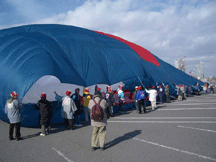 B. The Japanese version of the World's Largest Kite fills with air prior to flight.
B. The Japanese version of the World's Largest Kite fills with air prior to flight.
C.. The Japanese megakite takes flight.
D. Kite Aerial Photography view of Japanese version of World's Largest Kite, showing Tokyo skyline in the background.
Japan's Version of World's Largest Kite Takes Flight
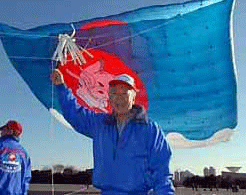 News media today (Jan. 15, 2006) reported that Masaaki Modegi, president of the Japan Kite Association and world renowned kite flyer, flew Japan's version of the world's largest kite on Jan. 8-9, 2006 at Harumi Pier in Tokyo's Chuo-ku. Assisted by a team of skilled kite fliers, the 25-metre by 40-metre (approx. 80 ft. x 132 ft.) kite flew at an altitude of 30 metres in a light breeze.
News media today (Jan. 15, 2006) reported that Masaaki Modegi, president of the Japan Kite Association and world renowned kite flyer, flew Japan's version of the world's largest kite on Jan. 8-9, 2006 at Harumi Pier in Tokyo's Chuo-ku. Assisted by a team of skilled kite fliers, the 25-metre by 40-metre (approx. 80 ft. x 132 ft.) kite flew at an altitude of 30 metres in a light breeze.
The kite was completed in November last year by New Zealand kite designer Peter Lynn. This was it's inaugural flight. It is expected that the kite will be flown in a number of festivals in Japan during the coming months.
This is the third kite of this size making the Japanese version one of a trilogy of kites that claims the current title of World's Largest Kite. The other two kites are owned by Kuwait and David Gomberg of Gomberg Kite Productions in Neotsu, OR, representing the United States.
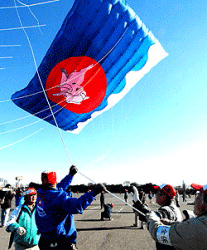 For more information on the world's largest kites visit my earlier Journal entry on this topic.
For more information on the world's largest kites visit my earlier Journal entry on this topic.
These kites are huge. They cover approximately 1.5 times the area of an NFL football field and require the application of stringent safety precautions to fly, generally at very low altitudes (typically around 30 metres).




